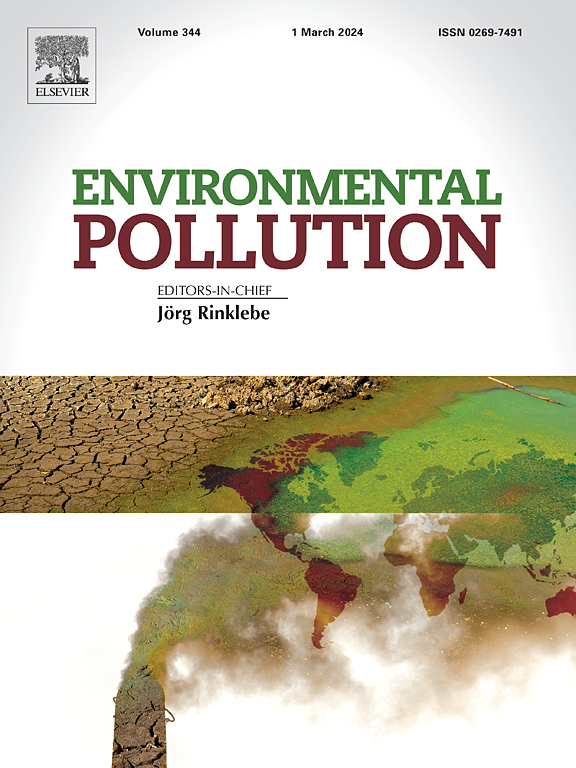Fate of heavy metals in the water-scarce Nile Delta lagoons: a post-Aswan Dam perspective
IF 7.3
2区 环境科学与生态学
Q1 ENVIRONMENTAL SCIENCES
引用次数: 0
Abstract
Deltas around the world are increasingly threatened by metal pollution, caused by human activity, endangering the health of vital ecosystems. This study presents a comprehensive review of the evolution of heavy metals in the arid Nile Delta, aiming to establish a model for the metals’ source-sink dynamics and their underlying drivers. Based on an overall assessment of heavy metal distribution across 639 sites interpreted by numerous previous studies, we synthesized individual datasets into an integrated delta-scale model, to reassess the source-sink pollution dynamics. Using pre-Aswan Dam data (prior to 1964) as a reference point, we defined major heavy metals (Pb, Cu, Zn, Cd, Cr, Mn, Sr, Ni) in deltaic surface sediments as being of anthropogenic origin, through statistical analyses. We found a latitudinal (south-to-north) increasing trend in anthropogenic metal concentrations, which were progressively transported from the delta plain to coastal lagoons over the past half-century. Integrated pollution indices revealed that metal concentrations in the lagoons were 3–4 times higher than those in various delta sectors, i.e. river branches, canals, drains, soils and coastal beaches, indicating a cumulative process-consequence following dam construction. The increasing enrichment factor (EF) values of lagoonal metals are closely correlated with proxies of social development, including wastewater discharge, fertilizer application, GDP, population, etc., among which the water stress level (WSL) plays a determinant role in raising EF value. In-depth study revealed a non-linear relationship between EF and WSL, indicating that lagoon sediments will lose their capacity to absorb anthropogenic metals by the end of 2060, implying an irreversible metal contamination crisis in the water-scarce Nile Delta. Our study calls for an urgent policy reform and implementation to improve coastal management.


缺水的尼罗河三角洲泻湖重金属的命运:后阿斯旺大坝的视角
世界各地的三角洲日益受到人类活动造成的金属污染的威胁,危及重要生态系统的健康。本文对干旱的尼罗河三角洲地区重金属的演变进行了综述,旨在建立重金属源汇动力学模型及其潜在驱动因素。在对639个站点的重金属分布进行全面评估的基础上,我们将单个数据集综合到一个综合的三角洲尺度模型中,以重新评估源汇污染动态。以阿斯旺大坝之前的数据(1964年以前)为参考点,通过统计分析,我们确定了三角洲表层沉积物中的主要重金属(Pb、Cu、Zn、Cd、Cr、Mn、Sr、Ni)是人为来源。在过去的半个世纪里,人为金属浓度呈纬度(由南至北)增加的趋势,从三角洲平原逐渐向沿海泻湖转移。综合污染指数显示,泻湖中的金属浓度比河流支流、运河、排水沟、土壤和海岸海滩等三角洲区域的金属浓度高3 ~ 4倍,表明大坝建设后的累积过程-后果。泻湖金属富集因子(EF)值的增加与社会发展指标密切相关,包括废水排放、化肥施用、GDP、人口等,其中水分胁迫水平(WSL)对EF值的提高起决定作用。深入研究发现,EF与WSL之间存在非线性关系,表明到2060年底,泻湖沉积物将失去对人为金属的吸收能力,这意味着缺水的尼罗河三角洲存在不可逆转的金属污染危机。我们的研究呼吁进行紧急的政策改革和实施,以改善沿海管理。
本文章由计算机程序翻译,如有差异,请以英文原文为准。
求助全文
约1分钟内获得全文
求助全文
来源期刊

Environmental Pollution
环境科学-环境科学
CiteScore
16.00
自引率
6.70%
发文量
2082
审稿时长
2.9 months
期刊介绍:
Environmental Pollution is an international peer-reviewed journal that publishes high-quality research papers and review articles covering all aspects of environmental pollution and its impacts on ecosystems and human health.
Subject areas include, but are not limited to:
• Sources and occurrences of pollutants that are clearly defined and measured in environmental compartments, food and food-related items, and human bodies;
• Interlinks between contaminant exposure and biological, ecological, and human health effects, including those of climate change;
• Contaminants of emerging concerns (including but not limited to antibiotic resistant microorganisms or genes, microplastics/nanoplastics, electronic wastes, light, and noise) and/or their biological, ecological, or human health effects;
• Laboratory and field studies on the remediation/mitigation of environmental pollution via new techniques and with clear links to biological, ecological, or human health effects;
• Modeling of pollution processes, patterns, or trends that is of clear environmental and/or human health interest;
• New techniques that measure and examine environmental occurrences, transport, behavior, and effects of pollutants within the environment or the laboratory, provided that they can be clearly used to address problems within regional or global environmental compartments.
 求助内容:
求助内容: 应助结果提醒方式:
应助结果提醒方式:


